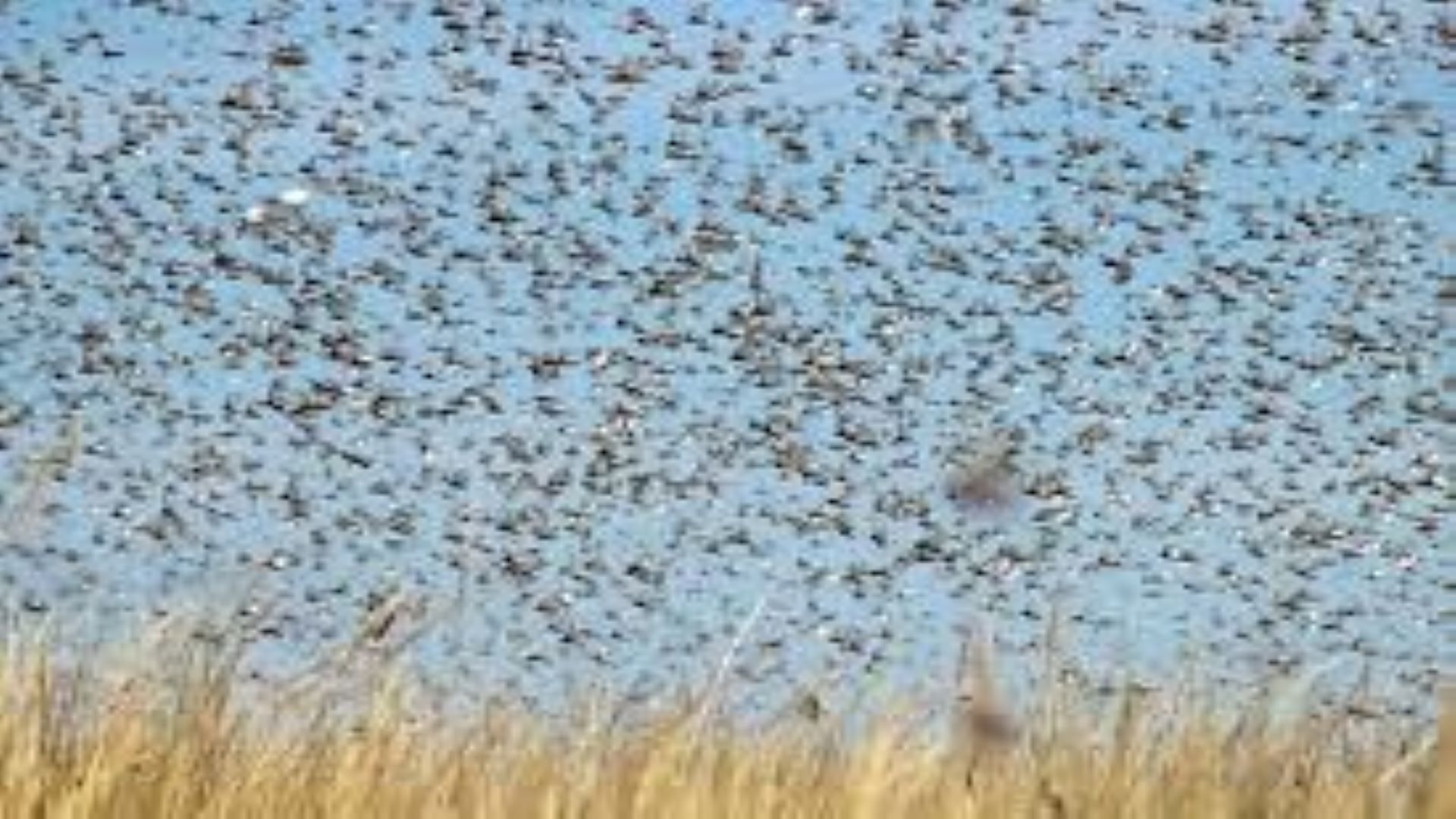Our cents
5
Reflections - news - topical issues

Speaking of “R” rates and Desert Locusts
With what were you consumed on your prolific WhatsApp groups in January 2020?
How to flatten the curve of Schistocerca gregaria, which has the potential to threaten the food security and livelihoods of one tenth of the world’s population[1], and to affect more than 20% of the total land surface of the world, affecting 60 countries[2] ? Desert locusts are the most destructive migratory pests in the world.[3]
Probably not, and yet:
- In January 2020, a very large population of desert locusts spread from Yemen into Kenya and quickly spread to Uganda. By February the UN stated that the swarms were the largest in Somalia and Ethiopia in 25 years and in Kenya in 70 years[4]. On 1st February, the Pakistanicgovernment declared a national emergency to counter the invasion of desert locusts. Estimates in March were that they numbered over 360 billion across these countries. By late May, they had reached India.
- The scale of the locust outbreak is like nothing in recent memory[5]. At their peak earlier this year, swarms were eating 1.8 million tonnes of vegetation a day[6].
- A swarm of 1 km2 eats the same amount of food in one day as 35,000 people. A swarm the size of Bamako (Mali) or Niamey (Niger) can consume what half the population of either country would eat in a single day[7]. Ok, you can’t relate to Bamako? Think about this – a swarm the size of Paris can eat the same amount of food in one day as half the population of France. One swarm recently reported in Kenya covered an area the size of Luxembourg[8].
Or were you ‘googling’ the ‘R’ rate of the desert locust?
- In March, predictions were that the insects, which eat their own body weight in food every day, were breeding so fast numbers could grow four hundredfold by June (that’s 40,000%)[9].
- If food is in adequate supply and the hoppers are not forced to crowd together when they emerge from the eggs, the locusts live their lives separately as do other grasshoppers. If, however, the hoppers are crowded together for one reason or another, they enter a gregarious phase of activity and swarm[10].
You could list the weekly ranking of the countries most affected, yes?
I suppose, like me, you considered organising a Shout Out in your neighbourhood every Monday night, clad in your PJs and slippers, to show your support for the frontline workers deployed to try and control swarms of those voracious little hoppers? What about a crowd-funder to help with the hundreds of millions needed ?
- Aerial and ground spraying combined with constant tracking of the swarms are viewed as the most effective strategies. But Desert Locust Control Organization for Eastern Africa head, Stephen Njoka, told BBC News that aircraft were in short supply. In January, the UN appealed for $76m to tackle the crisis. By March, the figure had risen to $138m. But on 10 March, the BBC reported that only $52 million had been received[11].
Were you worried about the long-term effects on the environment of the tonnes of chemicals that needed to be sprayed to control what was fast looking like a plague of Biblical proportions? Were you closely following the biological warfare options being proposed by the Chinese in the form of ducks? Yes, ducks. The common or garden, quacking variety.
- In February, Chinese authorities dispatched 100,000 birds to its Xinjiang border in the far west of the country, where it meets Pakistan and India as the locusts continued to swarm eastwards. Ducks can eat more than 200 locusts a day, compared with chickens which can manage just 70.[12]. (P.S Did you know that ducks are also more amenable to being herded than are chickens?)
Then in March you changed your Facebook status to let your friends know how closely you were following the likelihood of a second peak?
- The FAO reported that a favourable wet weather in March and beyond would lead to a second wave of swarms, posing an unprecedented threat to livelihoods once again. Insect numbers could grow another 20 times, the FAO warned, unless control activities are stepped up[13].
- By 9th June, a second generation of immature swarms had started to form in northwest Kenya[14], which was expected to peak in the last two weeks of June and then decline in July.
But should we worry our pretty little heads about every cyclone, flood, earthquake or locust swarm ravaging the planet when Coronavirus might be lurking around our grandfather’s (or our) front door? Especially if we don’t live in one of the countries thus affected? We can’t do anything about it anyway.
Or can we? Are we dealing with the same root cause?
As Rupa Mukerji reports in his May 26th blog,[15] pandemics are indicators of ecosystem damage just as storms are of climate change. In 2012 the IPCC (Intergovernmental Panel on Climate Change) reported on the links between climate change and extreme weather events. Heavy rains and hurricanes in East Africa, triggered by record high temperatures in the Indian Ocean, contributed to the current locust crisis. “Scientists have linked the current outbreak to unusually favourable climate and resultant ecological conditions, both in Arabia and Eastern Africa regions, primarily driven by climate change.” (medium.com, “Desert Locust Invasion in Eastern Africa,” April 8, 2020).
What if each one of us thought twice before we … hopped in our car for a 2kms drive to the shops? Or said ‘none’ when the teller at the shops asked us how many plastic bags we wanted for our shopping? Or decided that our delicate buttocks survived towelling nappies so our children’s will too (though I wonder about the washing powder to wash the towelling ones?). Or cut back our consumption of meat; or bought carrots by the bunch from a market, not in a plastic punnet with cling wrap? Or, when the power goes out, decide we can have a candle-lit dinner with good conversation rather than putting on the generator so that we don’t miss the next riveting episode of the Kardashians? We probably will never know if there were less locusts in that next swarm over East Africa as a result, but I bet there will be.
[1] https://library.wmo.int/doc_num.php?explnum_id=3213
[2] https://www.fao.org/ag/locusts/oldsite/LOCFAQ.htm
[3] https://www.mercycorps.org/blog/desert-locusts-east-africa
[4] https://www.bbc.co.uk/news/resources/idt-84994842-8967-4dfd-9490-10f805de9f68
[5] https://www.nationalgeographic.com/science/2020/02/locust-plague-climate-science-east-africa/
[6] https://www.bbc.co.uk/news/resources/idt-84994842-8967-4dfd-9490-10f805de9f68
[7] https://library.wmo.int/doc_num.php?explnum_id=3213
[8] https://www.theguardian.com/global-development/2020/mar/20/locust-crisis-poses-a-danger-to-millions-forecasters-warn
[9] https://www.bbc.com/news/in-pictures-51618188
[10] https://www.biology-resources.com/locust-01.html
[11] https://www.bbc.com/news/in-pictures-5161818810 March 2020
[12] https://www.express.co.uk/news/world/1245489/locust-plague-pakistan-africa-locust-swarm-attack-ducks-Xinjiang
[13] https://www.bbc.co.uk/news/resources/idt-84994842-8967-4dfd-9490-10f805de9f68
[14] https://www.fao.org/ag/locusts/en/info/info/index.html
[15] https://www.helvetas.org/en/switzerland/how-you-can-help/follow-us/blog/Other/corona-biodiversity-e?utm_source=Newsletter&utm_medium=email&utm_content=June+2020%3A+Reflections+from+the+COVID-19+Response&utm_campaign=%5Bhighlights%5D_4thCovidUpdate_25062020_en
Engage Q Partnership if you are interested in discussing these ideas further.

Agriculture House, 1 Adylinn Road (Corner Marlborough Drive) , Marlborough, Harare, Zimbabwe
Our Solutions
© 1999-2023 Q Partnership Management Consultants




